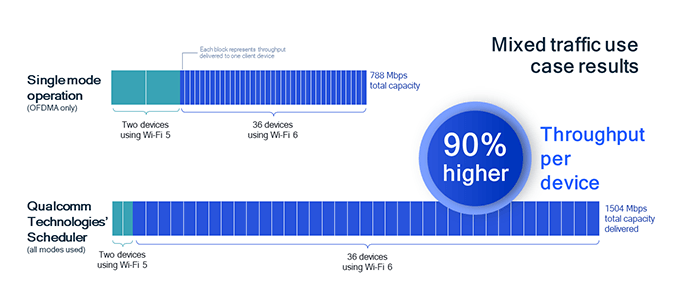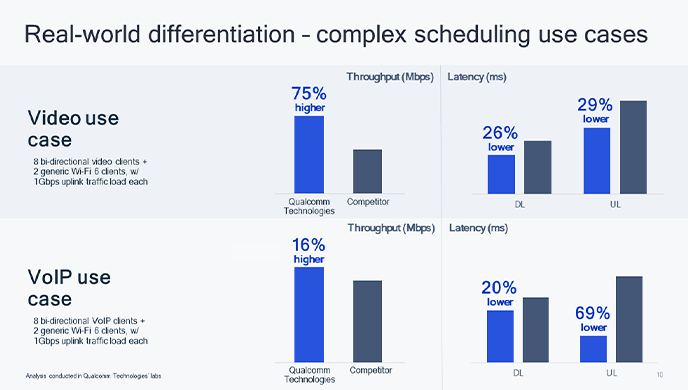Whitepaper: High performance scheduling unlocks Wi-Fi 6 potential

Wi-Fi 6 is built to address the challenges of today’s connectivity landscape, leveraging new or enhanced versions of technologies like OFDMA and bi-directional MU-MIMO to manage the multi-user, simultaneous usage patterns that define modern Wi-Fi networks. However, peak Wi-Fi 6 performance depends on both expert implementation of these tools and the ability to use them together. Ensuring the right tool is applied to the right requirement and optimizing the combination of capabilities at any given moment has elevated the role of the network scheduler to one of singular importance. Simply stated, performance of the Wi-Fi 6 network scheduler is the best predictor of overall Wi-Fi 6 performance in a modern network.
Recently, Qualcomm Technologies, Inc. demonstrated, through technical analysis, the importance of a high-performance network scheduler and published that analysis in a new research-based whitepaper. Our decades-long pedigree, derived from intensive research and development, yields a highly optimized network scheduler delivering significant performance advantages when compared to either legacy single-user scenarios or to competitors’ offerings.
The analyses were developed to measure both throughput and latency, key performance indicators across multiple intense usage network deployments. In one use case, the analysis illustrates the impact of Qualcomm Technologies’ scheduling in delivering airtime fairness (as measured in throughput per device) in a mixed client environment with both Wi-Fi 6 and Wi-Fi 5 devices.

Analysis conducted in Qualcomm Technologies’ labs.
Equal airtime fairness in mixed client environments is a critical factor in delivering a seamless Wi-Fi experience. Qualcomm Technologies set out to determine the impact our high-performance scheduler had on such a scenario. The results show an equal allocation of capacity, providing faster connections across all devices – Wi-Fi 6 and legacy – resulting in a significant performance boost per device. With up to 90 percent higher throughput per device, every user’s connectivity experience improved.
To further illustrate the performance of a Qualcomm Technologies’ scheduler, a second analysis was constructed with two scenarios. In these scenarios, the performance results between an access point based on the Qualcomm Networking Pro Series Wi-Fi 6 platform and a competitor’s Wi-Fi 6 access point were compared. These scenarios ran latency-sensitive real-time traffic, side by side, with heavy uplink traffic across the same network.

Analysis conducted in Qualcomm Technologies’ labs.
These analyses highlight implementation superiority. They also demonstrate the significant role our highly optimized scheduler plays in the real-time balancing between OFDMA use for the benefit of multiple users with relatively small payloads or MU-MIMO for multiple users with large payloads without having to sacrifice on either throughput (with an increase of up to 75 percent where throughput is the KPI) or latency (with an overall decrease of up to 69 percent in use cases where latency is the KPI).
Overall, these analyses clearly illustrate that the full performance benefits of Wi-Fi 6 are only achieved through high-performance network scheduling. Qualcomm Technologies’ highly differentiated high-performance Wi-Fi 6 network scheduler is offered across our networking product portfolios, supporting our customers to deliver leading-edge connectivity in the home, school, public, and enterprise environments. From video conferencing and gaming to voice and beyond, unlocking the full benefits Wi-Fi 6 is transforming industries and empowering new and improved experiences for users.
